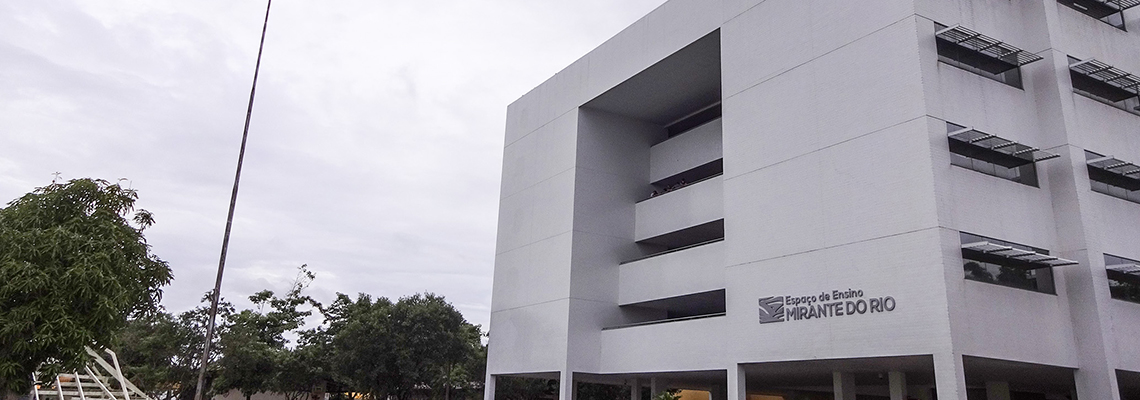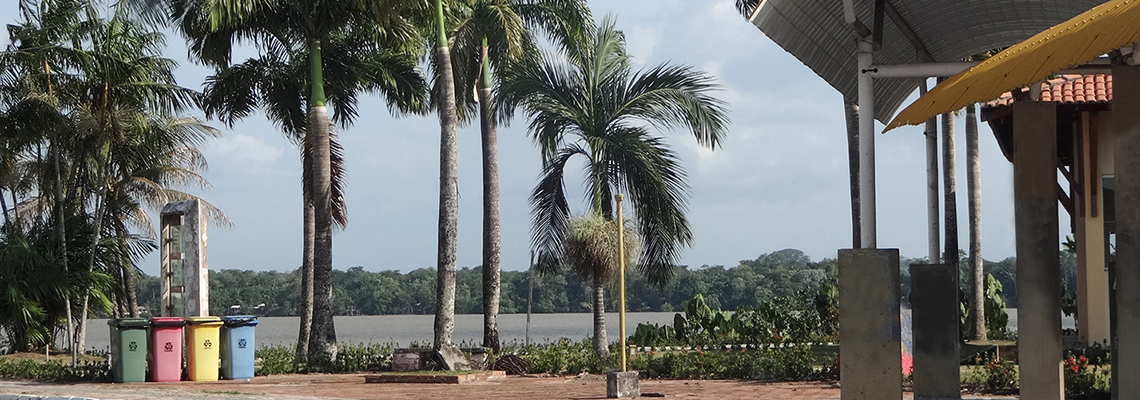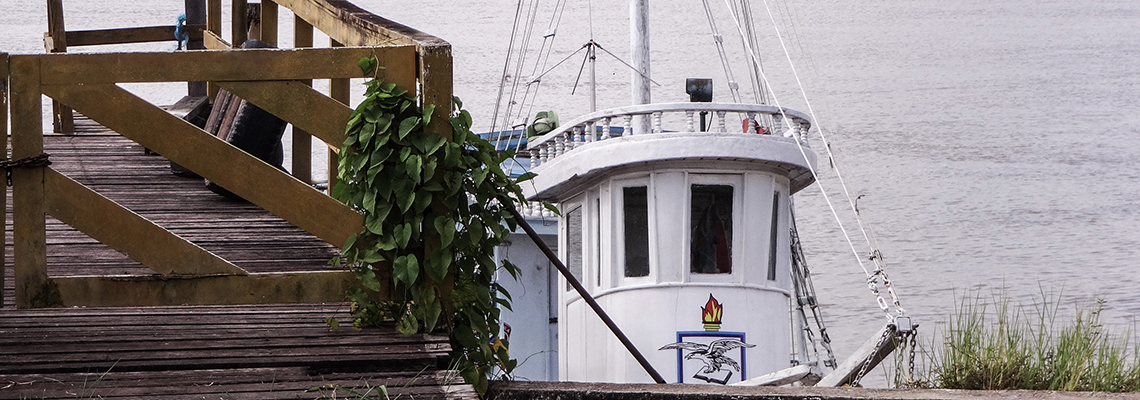Primate Experimental School (EEP)
Description: EEP has been developing collaborations with Software Engineers for the development of virtual environments for the research of cognitive behavior in capuchin monkeys. With the team of Professor Maria da Conceição Pinheiro and Professor Luiz Carlos da Silveira, neurophysiologists and pediatricians are developing cross-cultural tests to study cognitive development problems in children infected with methylmercury in gold mining areas in the state of Pará. This ongoing research should also count on the collaboration of the LaPer and Professor Givago Souza, Anderson Raiol, Manoel da Silva Filho, Bruno Gomes and Fernando Rocha, among others. It has a 120 m2 building, with a veterinary clinic with equipment for minor surgeries and a microscope for clinical examinations, teachers' rooms, kitchen with three rooms (reception, preparation, dirty room), bathroom. A control room and two cubicles with two experimental chambers in each, one with visual isolation and acoustic attenuation. Each of the four experimental chambers is controlled by means of a computer with two monitors, one in the control room and one with a sensitive screen, attached to the experimental chamber. A video server with a video camera system with one camera in each experimental camera, for filming the experimental sessions. In the control room there are also two work benches with computers and a printer for general work. The vivarium has four 16.0 m3 nursery cages and three 8.0 m3 cages.
Coordination: Professor Olavo Galvão, Professor Ana Leda Brino and Professor Paulo Goulart.
Funding: CNPq Universal Notice; PNPD CAPES; INCT-ECCE CNPq / FINEP; NIEH.
Laboratory of Social Learning and Human Development (LASDH)
Description: Composed of two rooms: one for collection and another for data analysis. Data collection room (12.5m2): divided into two environments by a panel with a unidirectional mirror for observation sessions of caregiver-child interactions (environment 1) and interviews with caregivers (environment 2). It has two internet points, a notebook, desk, three chairs, tatami mat for interactions and a mirror. Data analysis room (30m2): with meeting table, two shelves, two cabinets, bench with four computers, three internet points, router, external HD (1 tera) for storing videos and data, two printers (one laser), common toys and with remote control for the different experimental tasks, two handcam camcorders, white board for classes / group meetings. Holds between six and eight people.
Coordination: Professor Marilice Garotti.
Laboratory of Control of Rules (LCR) - NTPC
Description: The Laboratory of Control of Rules (LCR) has been developing basic research on the functions of the verbal environment and the non-verbal environment and applied research, related to basic research, on adherence to the rules of treatment of patients with chronic diseases (these in collaboration with health teams) and the role of rules in the installation of pro-study behaviors (these in collaboration with education teams). It has two rooms of 20 m2 each, with benches, seven computers, three printers, three camcorders, cabinets and a table with a unidirectional mirror for data collection. It also has portable computers for collection in field studies.
Coordination: Professor Carla Paracampo and Professor Luiz Carlos de Albuquerque.
Funding: CNPq (3 / 2010-2 / 2012 - Universal Notice).
Laboratory of Advanced Studies in Evolutionary Psychology (LEAPE)
Description: LEAPE has been developing collaborations with ethnologists in research on the patterns of mother-child interaction in an indigenous Amazonian village (Assurini, Rio Xingu). 12.5 m2 room with bench with computers, printers, camcorders, cabinets, shelves, with bench for five people; three internet points, wireless.
Coordination: Professor Regina Brito.
Gender Studies Laboratory (LEG)
Description: LEG has been located at the Behavior Theory and Research Center since 2009 with the aim of developing the following projects:
"Criteria for selecting partners chosen by homo and heterosexual users of a website for romantic relationships" and "Analysis of the environmental determinants of spatial orientation in men and women". The physical space comprises a room 4 m x 5 m with three computers (two connected to the internet), a printer, a table, a bookcase and cabinets. LEG has the collaboration of Professor Paulo Goulart, a PIBIC fellow and a group of volunteer students. For research on spatial orientation, UFPA buildings or areas are used.
Coordination: Professor Alda Loureiro Henriques.
Neuroanatomy Laboratory of the Amazon Sounds Laboratory Jaques Villiard
Description: It has a room of 20 m2, with a bench with computers, printer, binocular and fluorescence microscope, chapel, H20 distiller with, cryostat, system for processing neural material slides for brain mapping of cortical areas for processing and learning sonorous.
Coordination: Professor Silene Maria Araújo de Lima.
Neurobiology Laboratory (LNB)
Description: LNB develops interdisciplinary studies in the project Nucleus of Excellence in Emerging Neuropathologies - Development of technology for neurophysiological monitoring of the health of Amazonian populations (CNPq-PRONEX / SECTAM-FUNTEC), and we are in the integration phase of LNB projects involving contamination by mercury in the levels of diagnosis and prophylaxis with the EEP project to study cognitive development problems. It has a 60 m2 room, with a bench with computers, printer, binocular and fluorescence microscope, chapel, H20 distiller with, cryostat, neural material slide processing system for histology and neural tissue immunocytochemistry.
Coordination: Professor Manoel da Silva Filho.
Funding: CNPq-PRONEX / SECTAM-FUNTEC; FAPESPA (Public Notice 003/2012).
Neurophysiology Laboratory Eduardo Oswaldo Cruz
Description: The Laboratory of Neurophysiology Eduardo Oswaldo-Cruz is currently structured for electrophysiological records obtained in humans and animal models. The set of devices, with small changes, allows the recording of isolated units of the retina, lateral geniculate nucleus and visual cortex, or the recording of field potentials, such as electrocardiogram, electroretinogram and electroencephalogram in animals. We are currently investigating visual changes caused by diseases that alter hormonal functioning in animal models of diabetes and hypothyroidism.
The structure consists of an anti-vibration table, a stereotactic device for medium-sized animals, a telethermometer and an electrothermal blanket, anesthetic equipment (Narcosul), artificial respirator (Ugo Basile), CO2 analyzer (Hartmann & Braun), model 71102 infusion pump ( B. Braun Melsungen), ophthalmoscope (Welch Allyn), micromanipulator for microelectrodes, MEZ-7101 preamplifier (Nihon Kohden), VC11 oscilloscope (Nihon Kohden), Retinophot-2 retinal chamber (Carl Zeiss Jena), model R-5031 oscilloscope (Tektronix), model 5113 oscilloscope (Tektronix), D130 amplitude discriminator (Digitimer), CED1401plus analog-digital interface (Cambridge Electronic Design), 450MHz Pentium III microcomputer, 64MB RAM, 6GB disk, 14 "SVGA video monitor with Spike2 (Cambridge Electronic Design) bioelectric signal processing program The microcomputer interacts with a CED 1708 interface, which controls a Pic stimulus generator system asso (Innisfree), which displays stimuli on a high-resolution, high-brightness monitor model 608 (Tektronix).
Tropical Neurology Laboratory
Description: The work of the tropical neurology laboratory involves investigations into the visual system in conditions of disease and health, applying mathematical models for the development of protocols that enable the detection of visual losses even before other clinical symptoms. It has two 40 m² rooms with a CED 1401 visual electrophysiology system, a VERIS visual electrophysiology system, 1 ViSaGe visual stimulus system, a cataract quantifier, anomaloscopes, a lensometer, a Macintosh workstation, an office complete eye care, 10 computers, a CAD color vision assessment system, a TCV color assessment system, a Humphrey static perimeter, an autorefractometer. The tropical neurology laboratory has two biologists, one biomedical, two physiotherapists, an agronomist, two nutritionists, a nurse, two doctors in its body of work.
Coordination: Professor Givago da Silva Souza.
Funding: PRONEX 2009 - FAPESPA / CNPq; Universal 2010 - CNPq; PROLAB 2012 - IBRO / LARC; PPSUS 2009 - FAPESPA; PROCAD - CAPES.
Perception Laboratory (LaPer)
Description: LaPer was born within the Research Program of the Experimental Primate School, from collaboration between researchers from the Theory and Behavior Research Center and from the Tropical Medicine Center, UFPA, and from the USP Psychology Institute, for the behavioral study of color vision in tropical primates. This collaboration began under the Brazilian Network of Neuroscience Institute (IBN-Net) project, financed by the FINEP / FADESP agreement Ref 4191/05 (Transversal Action Order, Ordinance No 01.06.0842-00, Agreement 1723). Currently, it receives Funding from CNPq-Edital Universal (14/2011) nº 484228 / 2011-0, for the project “Application of a Computerized Procedure Adapted for the Investigation of the Color Vision of Capuchin Monkeys (Cebus cf. apella) and Monkeys Guariba (Alouatta caraya)”, carried out in partnership with the National Primate Center (CENP, Ananindeua-PA) and with the participation of proponents Ana Leda Brino and Givago Souza. LaPer has the external collaboration of researchers Dora Fix Ventura and Daniela Maria Oliveira Bonci (IP-USP), Luiz Carlos de Lima Silveira (NMT-UFPA) and José Augusto Pereira Carneiro Muniz (CeNP-PA). It has a 12.5m2 room, with a data collection bench, an experimental chamber, special equipment for manipulation and presentation of visual stimuli (high performance CRT monitor and ViSaGe stimulus generator), two desktop computers for programming, monitoring and analysis of the experimental sessions, cabinets.
Coordination: Professor Paulo Goulart and Professor Olavo Galvão.
Funding: CNPq (Universal Notice 14/2011).
Amazon Sound Laboratory and Archive Jaques Villiard - Bioacoustic Laboratory (LoBIO)
Description: At LoBio, studies such as the “Eto-ecological Study of Botos and Parrots are developed to subsidize Ecotourism Activities in the Region of Belém” with collaboration with behavioral scientists. It has 120 m², with four computers, hydrophone, luximeter, two dynamometers, high resolution refractometer for salinity, portable amplified speaker, eight binoculars, two solid state digital recorders, three DAT recorders, 2 GPS, two ultradirectional microphones, applications for statistical and sound analysis.
Coordination: Professor Maria Luisa da Silva.
Funding: FAPESP.








